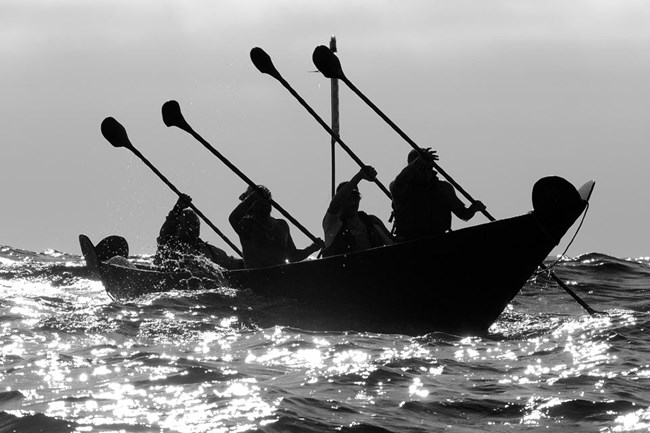
Robert Schwemmer/NOAA Each day, commercial and private boats take visitors across the Santa Barbara Channel to the shores of the Channel Islands. Can you imagine making that same journey in a canoe? It might take an entire day and would require tremendous physical strength to forge through the rough waters. Hundreds of years ago, the native island Chumash traveled these ancient waters for hunting, fishing, and trading. They built canoes, called tomols, from redwood trees that drifted down the coast, fastening the cut planks together with animal sinews and sealed with a tar-like substance called yop. Yop is a combination of pine pitch and asphaltum which occurs naturally in the Channel and along the coast from oil seeping into the water from below the earth’s surface. The tomol remains the oldest example of an ocean-going watercraft in North America. The tomol is central to the Chumash heritage, constructed and paddled by members of the Brotherhood of the Tomol. The historic Brotherhood disbanded in 1834, but in 1976, a contemporary group built Helek, which means Peregrine Falcon, based on ethnographic and historic accounts of tomol construction. It was the first tomol built in 142 years and the modern paddlers travelled from San Miguel Island to Santa Rosa Island, and finally to Santa Cruz Island. Twenty years later, the Chumash Maritime Association completed a 26-foot-long tomol which they named ‘Elye’wun (pronounced “El-E-ah-woon”), the Chumash word for Swordfish. On September 8, 2001, ‘Elye’wun made the historic crossing from the mainland to Santa Cruz Island. The dangers of the past did not escape the modern crew. During the journey, the tomol began to leak and also encountered a thresher shark and several dolphins. Over 150 Chumash families and friends gathered to greet the tomol and paddlers on the beaches of Santa Cruz. Three years later, on September 11, 2004, ‘Elye’wun again crossed the Channel to Santa Cruz Island, this time greeted by more than 200 Chumash and American Indians at the historic Chumash village of Swaxil, now known as Scorpion Valley. The 21-mile trip took over ten hours! A crew of Chumash youth aged 14 to 22 joined the paddlers, a significant accomplishment for the next generation of Chumash leaders. Additional tomol crossings took place in September 2005 and August 2006. Members of the Chumash community continue to celebrate their heritage and culture through this event. Centuries ago, the tomol was used to connect different island Chumash groups with each other and the mainland. Today, it links past generations of Chumash with the present-day Chumash community. You can read about history of the Channel Islands Chumash by following this link. Check out the Santa Barbara Museum of Natural History for more information about the Chumash and current archeology. 
Channel Islands National Park |
Last updated: August 27, 2024
